Students’ Responses to CL-Based Teaching of English Prepositions
Most EFL textbooks suggest the use of vivid
pictures and verbal explanations in teaching English
prepositions. However, this word class appears in
collocations, and rote-learning does not really help
learners retain and use this word class successfully.
Cognitive linguistics (CL) has implications for English
language teaching as it rests against the relationship
between the human mind and language. Several
experimental studies have aimed to investigate the
effects of CL-based treatment on learners’ retention of
target foreign or second language. However, most of
these studies have not placed an emphasis on the
learners’ opinions of CL-based teaching. This current
study aimed to collect college students’ responses to
CL-based teaching of English prepositions.
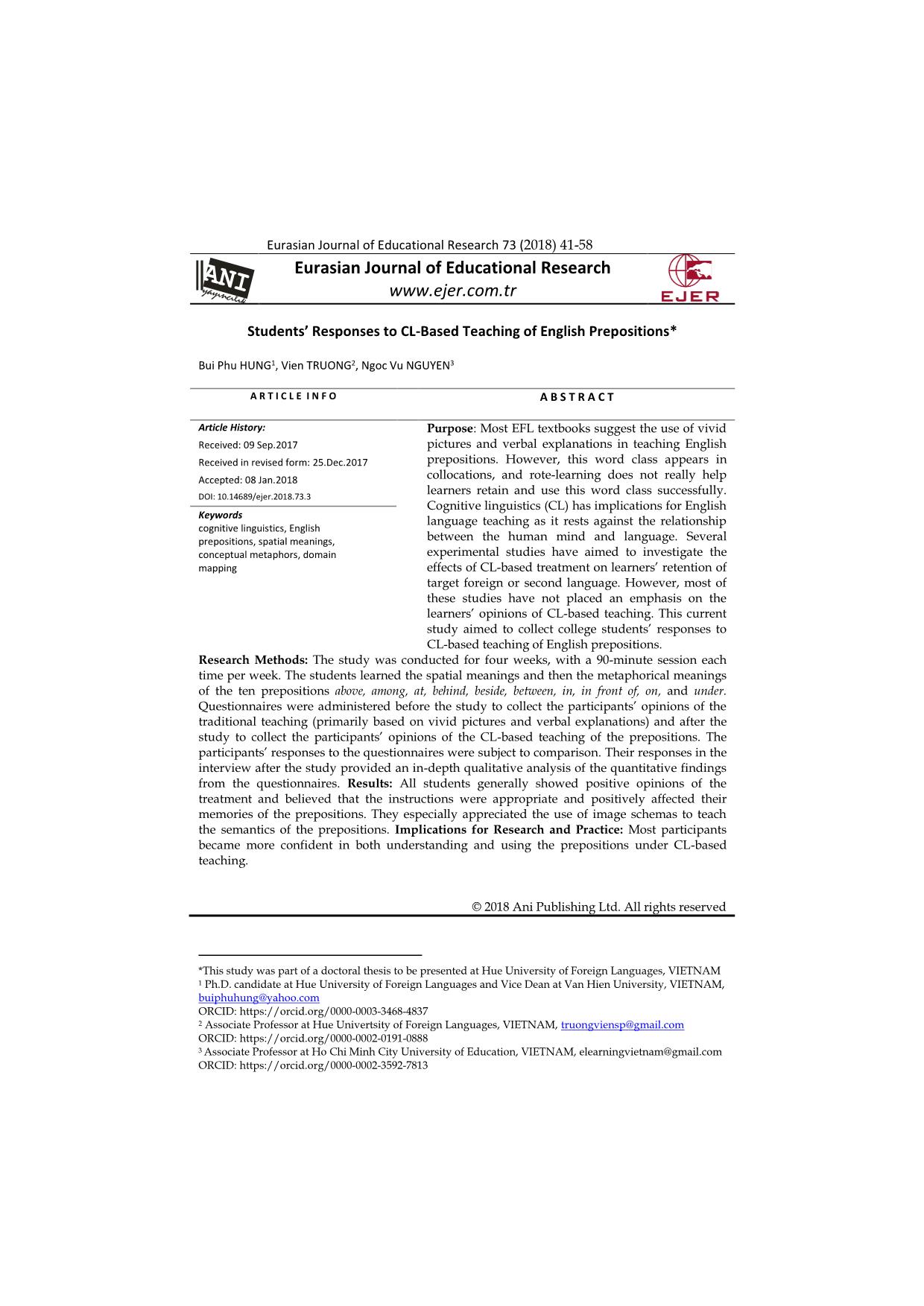
Trang 1
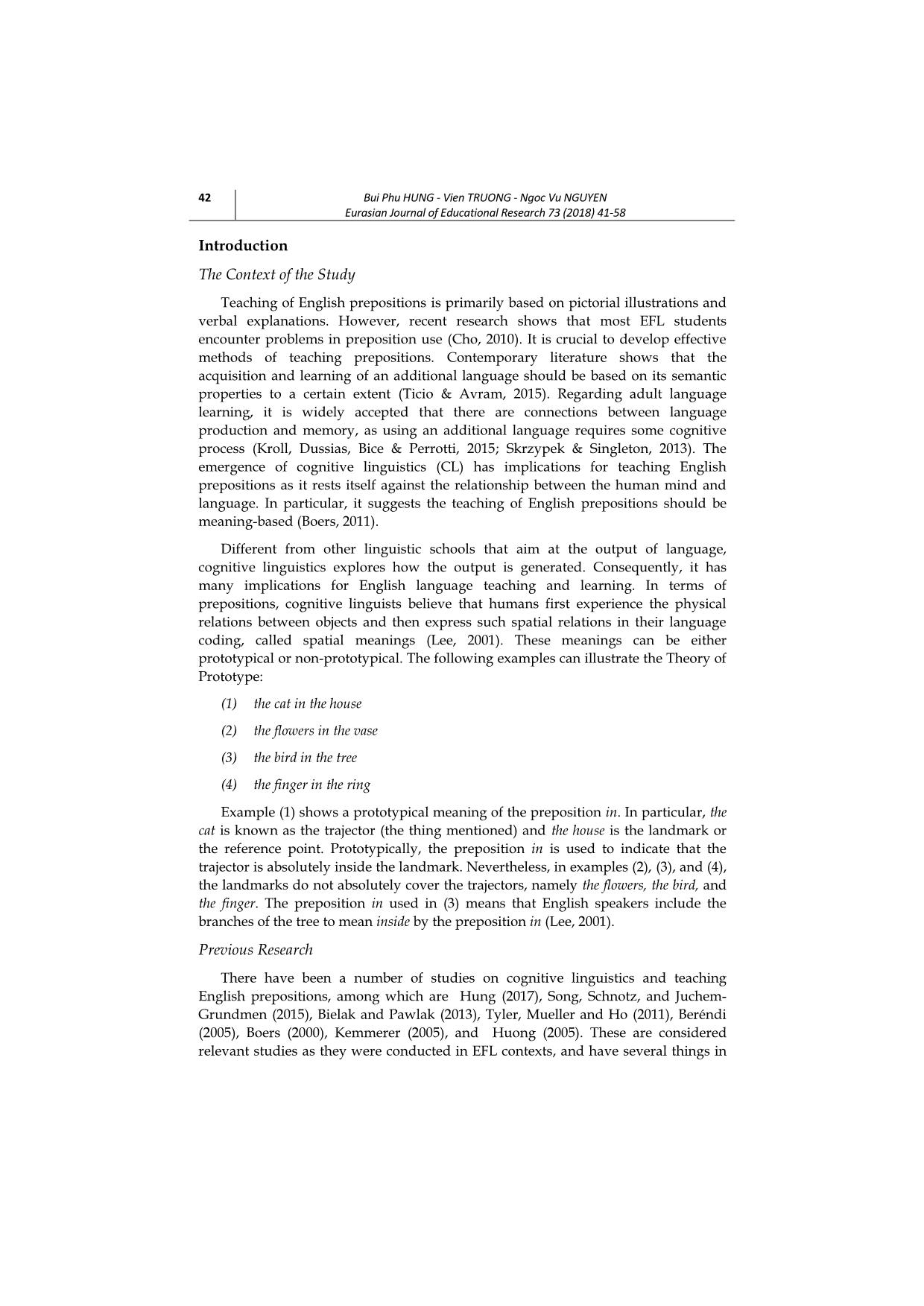
Trang 2
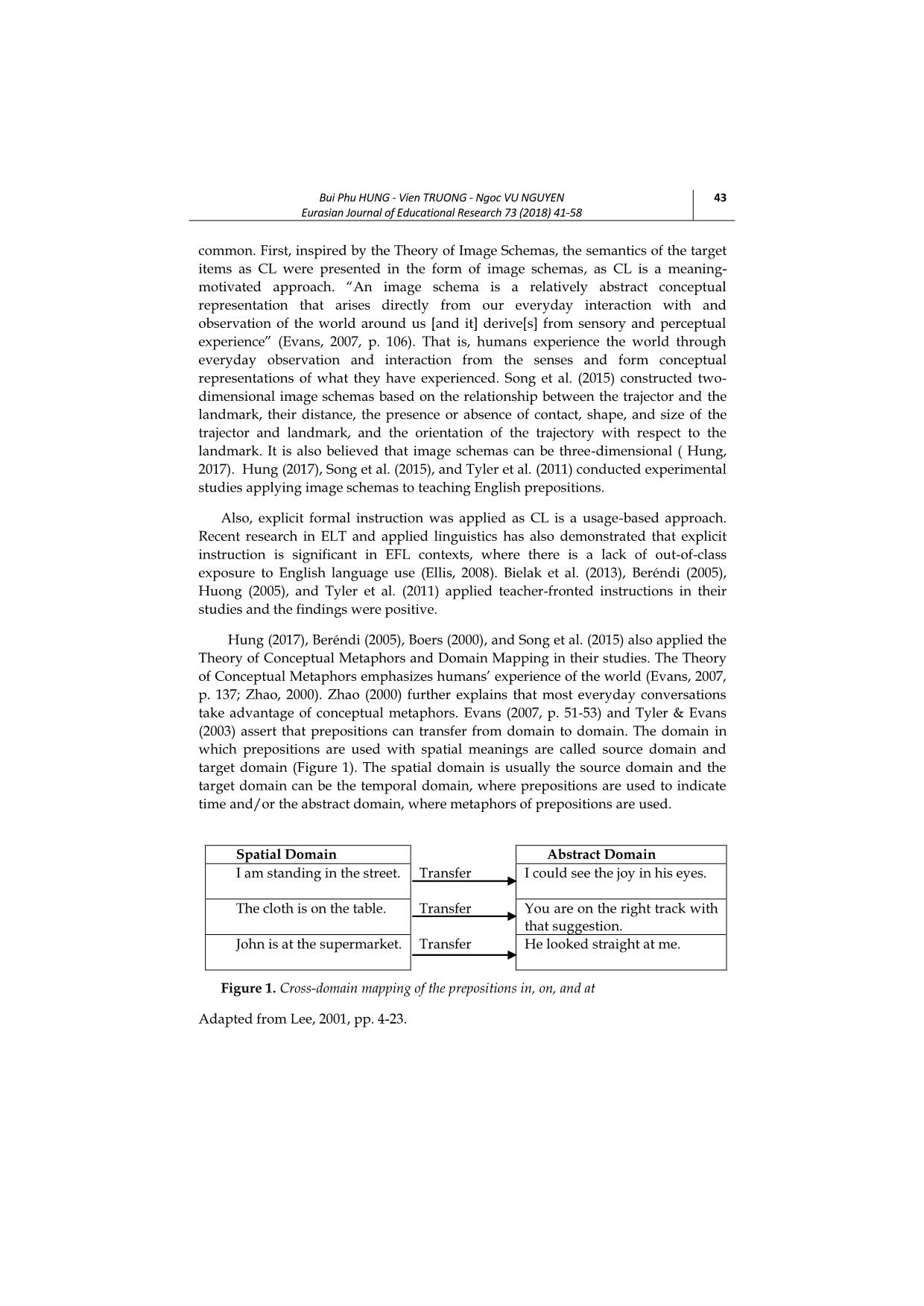
Trang 3

Trang 4
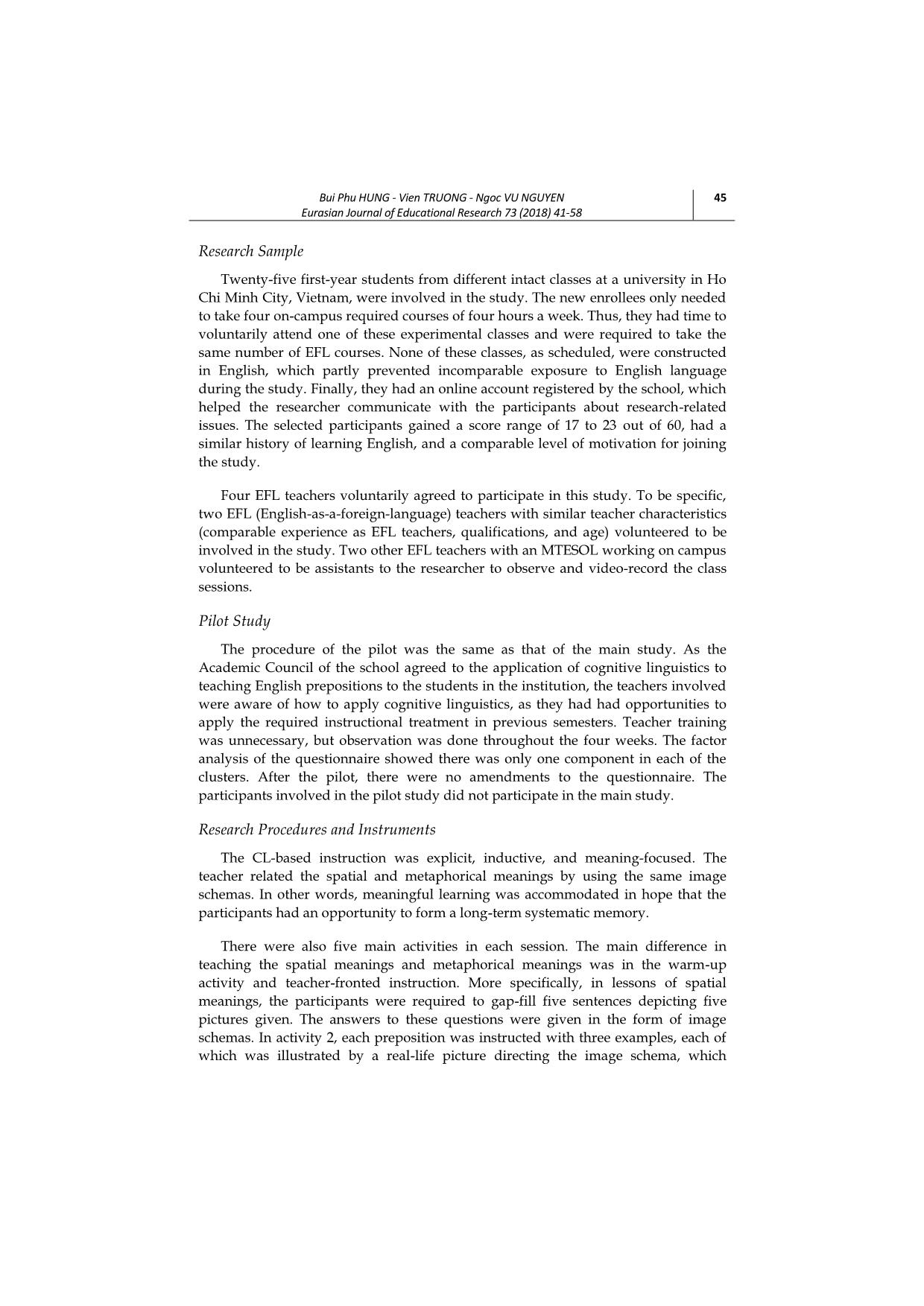
Trang 5
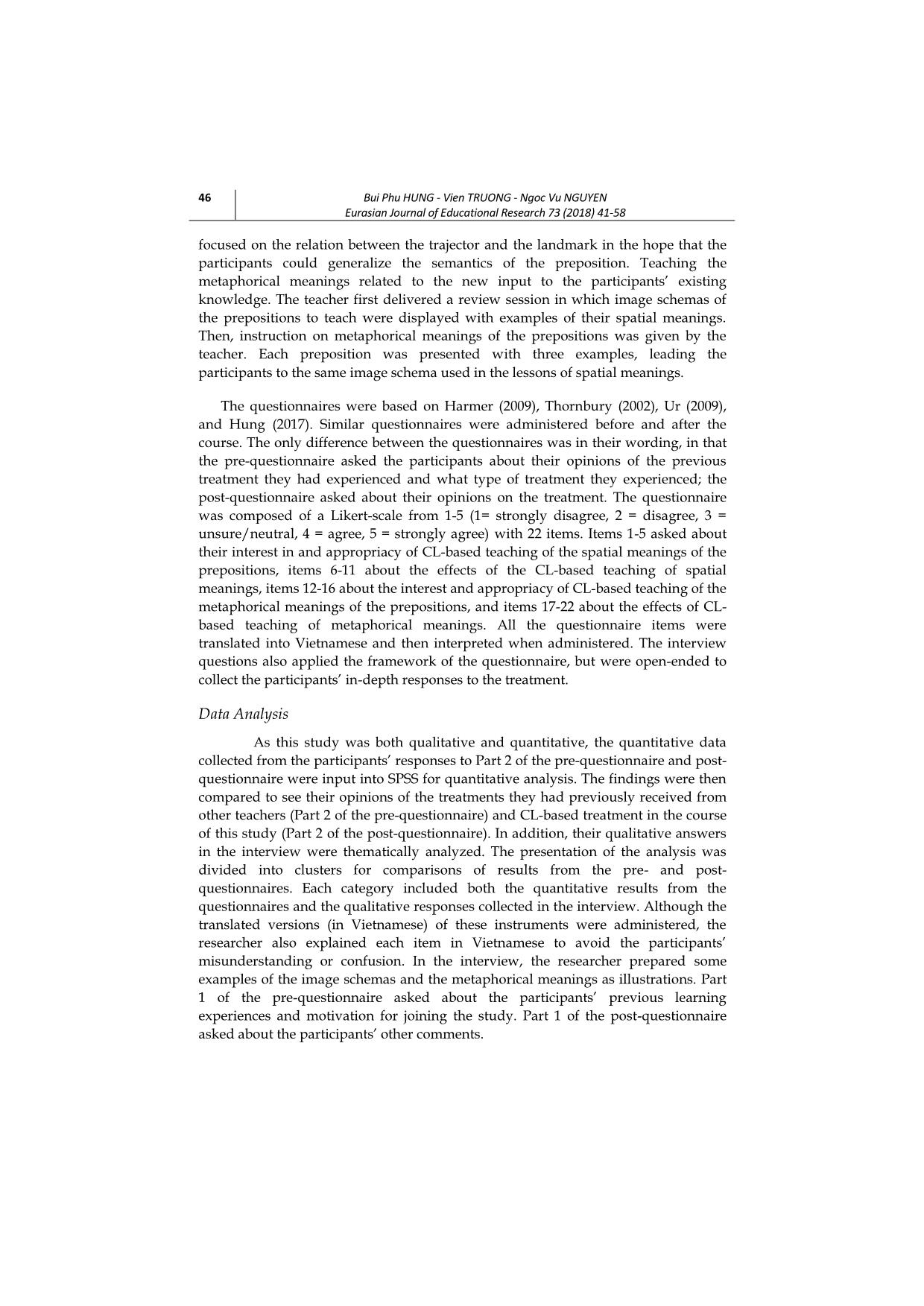
Trang 6
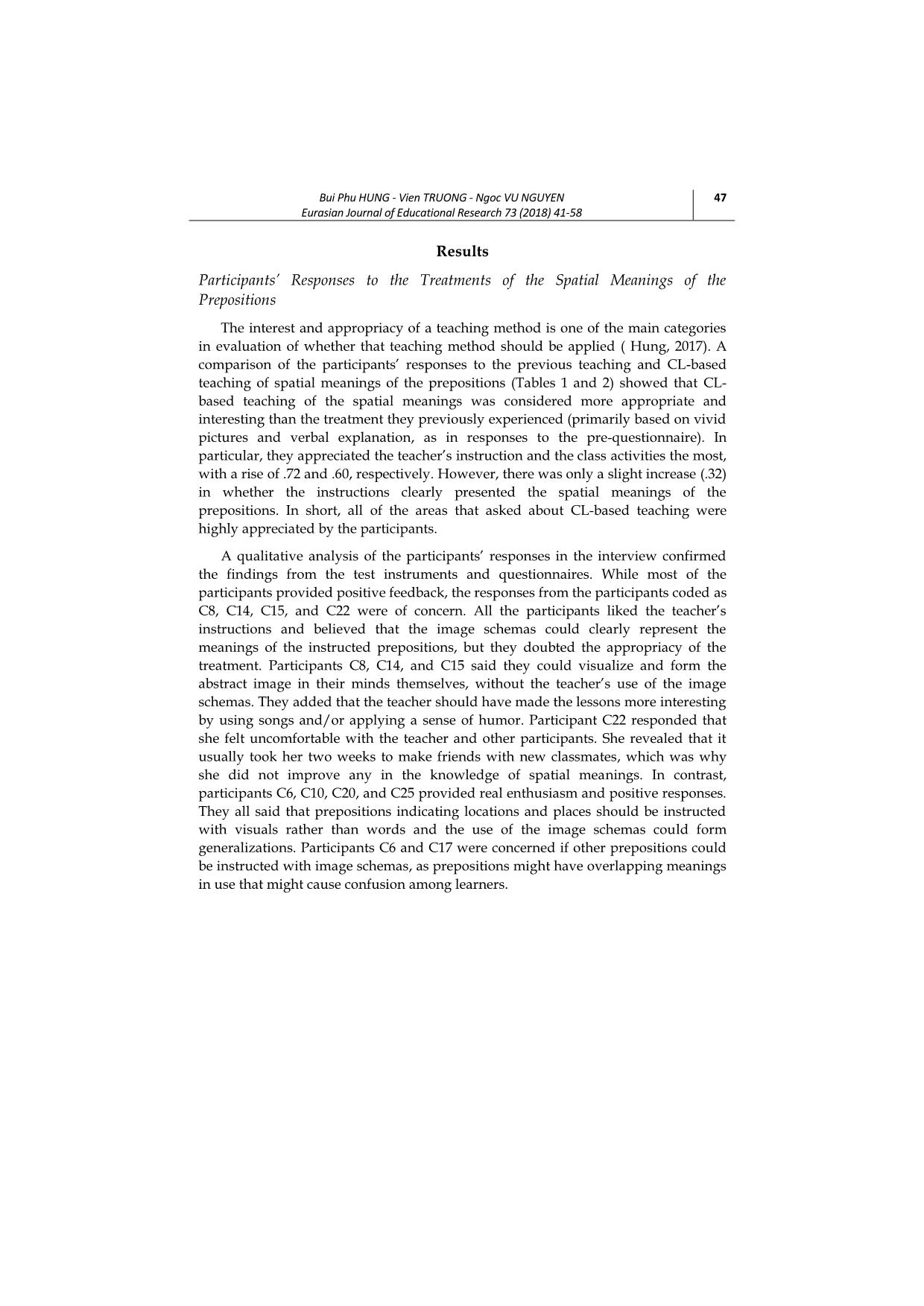
Trang 7
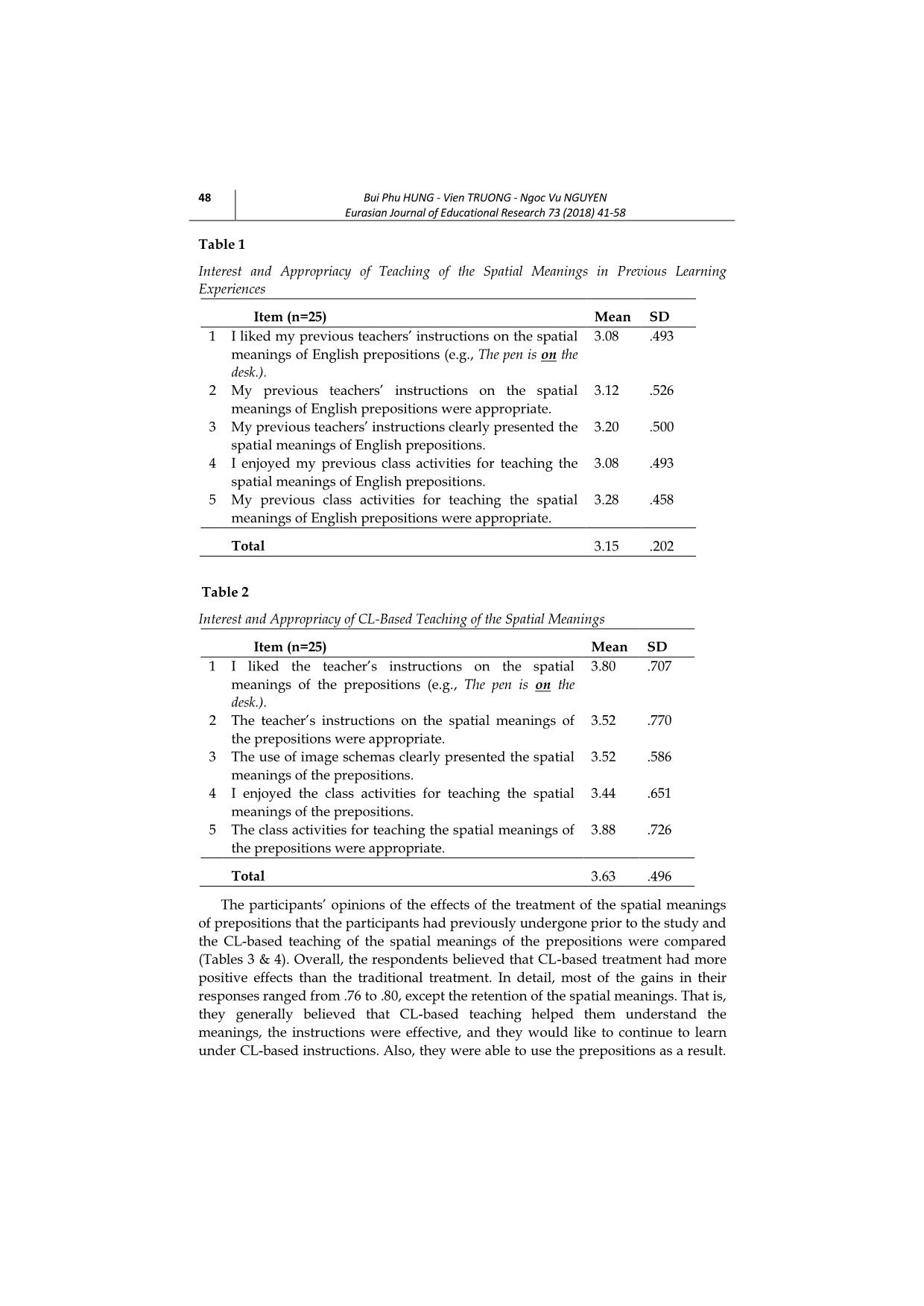
Trang 8

Trang 9
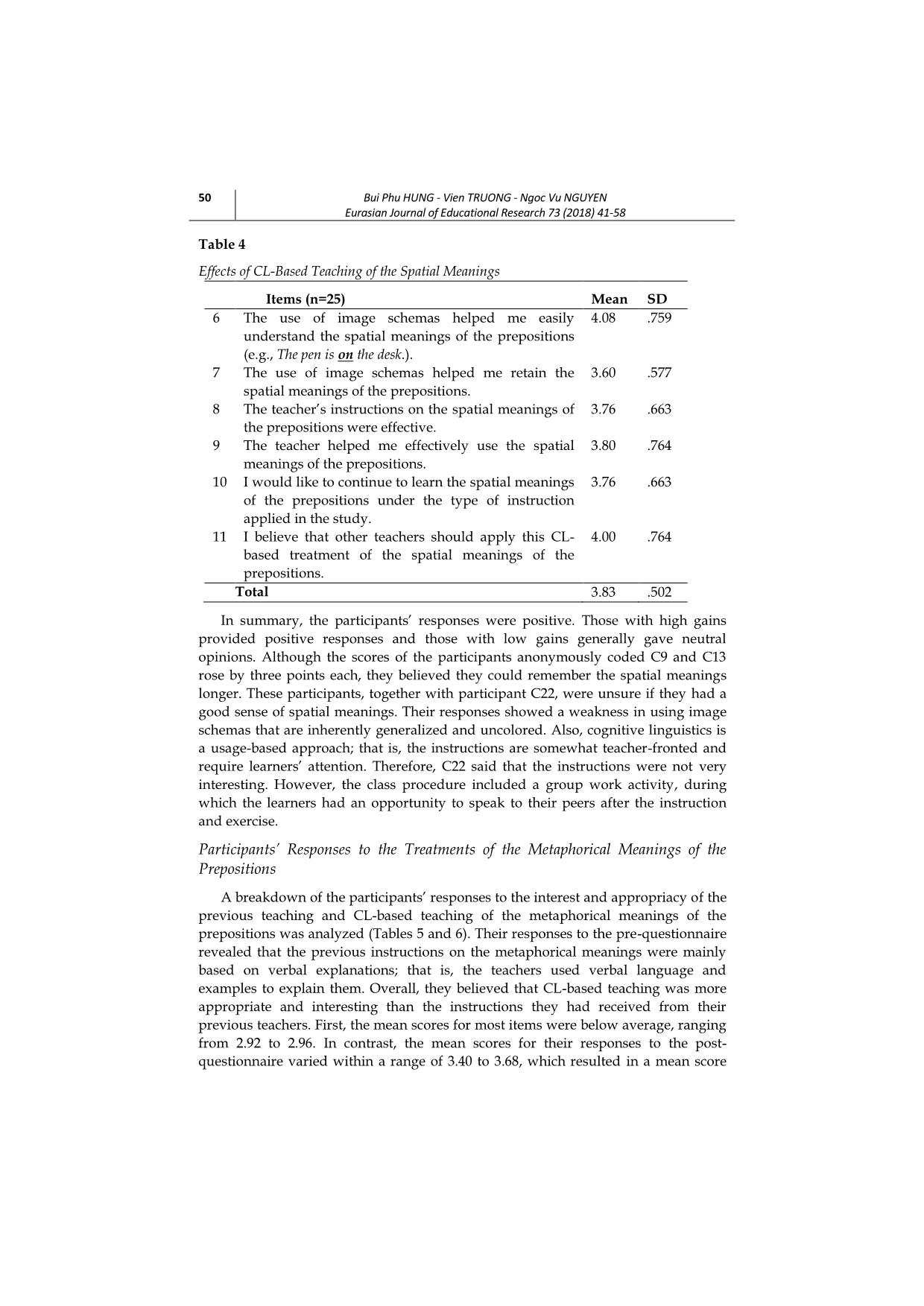
Trang 10
Tải về để xem bản đầy đủ
Tóm tắt nội dung tài liệu: Students’ Responses to CL-Based Teaching of English Prepositions
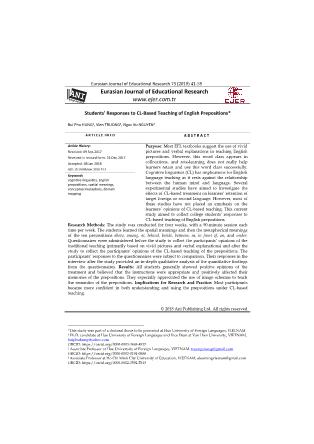
Eurasian Journal of Educational Research 73 (2018) 41-58 Eurasian Journal of Educational Research www.ejer.com.tr Students’ Responses to CL-Based Teaching of English Prepositions* Bui Phu HUNG1, Vien TRUONG2, Ngoc Vu NGUYEN3 A R T I C L E I N F O A B S T R A C T Article History: Purpose: Most EFL textbooks suggest the use of vivid pictures and verbal explanations in teaching English prepositions. However, this word class appears in collocations, and rote-learning does not really help learners retain and use this word class successfully. Cognitive linguistics (CL) has implications for English language teaching as it rests against the relationship between the human mind and language. Several experimental studies have aimed to investigate the effects of CL-based treatment on learners’ retention of target foreign or second language. However, most of these studies have not placed an emphasis on the learners’ opinions of CL-based teaching. This current study aimed to collect college students’ responses to CL-based teaching of English prepositions. Received: 09 Sep.2017 Received in revised form: 25.Dec.2017 Accepted: 08 Jan.2018 DOI: 10.14689/ejer.2018.73.3 Keywords cognitive linguistics, English prepositions, spatial meanings, conceptual metaphors, domain mapping Research Methods: The study was conducted for four weeks, with a 90-minute session each time per week. The students learned the spatial meanings and then the metaphorical meanings of the ten prepositions above, among, at, behind, beside, between, in, in front of, on, and under. Questionnaires were administered before the study to collect the participants’ opinions of the traditional teaching (primarily based on vivid pictures and verbal explanations) and after the study to collect the participants’ opinions of the CL-based teaching of the prepositions. The participants’ responses to the questionnaires were subject to comparison. Their responses in the interview after the study provided an in-depth qualitative analysis of the quantitative findings from the questionnaires. Results: All students generally showed positive opinions of the treatment and believed that the instructions were appropriate and positively affected their memories of the prepositions. They especially appreciated the use of image schemas to teach the semantics of the prepositions. Implications for Research and Practice: Most participants became more confident in both understanding and using the prepositions under CL-based teaching. © 2018 Ani Publishing Ltd. All rights reserved *This study was part of a doctoral thesis to be presented at Hue University of Foreign Languages, VIETNAM 1 Ph.D. candidate at Hue University of Foreign Languages and Vice Dean at Van Hien University, VIETNAM, buiphuhung@yahoo.com ORCID: https://orcid.org/0000-0003-3468-4837 2 Associate Professor at Hue Univertsity of Foreign Languages, VIETNAM, truongviensp@gmail.com ORCID: https://orcid.org/0000-0002-0191-0888 3 Associate Professor at Ho Chi Minh City University of Education, VIETNAM, elearningvietnam@gmail.com ORCID: https://orcid.org/0000-0002-3592-7813 42 Bui Phu HUNG - Vien TRUONG - Ngoc Vu NGUYEN Eurasian Journal of Educational Research 73 (2018) 41-58 Introduction The Context of the Study Teaching of English prepositions is primarily based on pictorial illustrations and verbal explanations. However, recent research shows that most EFL students encounter problems in preposition use (Cho, 2010). It is crucial to develop effective methods of teaching prepositions. Contemporary literature shows that the acquisition and learning of an additional language should be based on its semantic properties to a certain extent (Ticio & Avram, 2015). Regarding adult language learning, it is widely accepted that there are connections between language production and memory, as using an additional language requires some cognitive process (Kroll, Dussias, Bice & Perrotti, 2015; Skrzypek & Singleton, 2013). The emergence of cognitive linguistics (CL) has implications for teaching English prepositions as it rests itself against the relationship between the human mind and language. In particular, it suggests the teaching of English prepositions should be meaning-based (Boers, 2011). Different from other linguistic schools that aim at the output of language, cognitive linguistics explores how the output is generated. Consequently, it has many implications for English language teaching and learning. In terms of prepositions, cognitive linguists believe that humans first experience the physical relations between objects and then express such spatial relations in their language coding, called spatial meanings (Lee, 2001). These meanings can be either prototypical or non-prototypical. The following examples can illustrate the Theory of Prototype: (1) the cat in the house (2) the flowers in the vase (3) the bird in the tree (4) the finger in the ring Example (1) shows a prototypical meaning of the preposition in. In particular, the cat is known as the trajector (the thing mentioned) and the house is the landmark or the reference point. Prototypically, the preposition in is used to indicate that the trajector is absolutely inside the landmark. Nevertheless, in examples (2), (3), and (4), the landmarks do not absolutely cover the trajectors, namely the flowers, the bird, and the finger. The preposition in used in (3) means that English speakers include the branches of the tree to mean inside by the preposition in (Lee, 2001). Previous Research There have been a number of studies on cognitive linguistics and teaching English prepositions, among which are Hung (2017), Song, Schnotz, and Juchem- Grundmen (2015), Bielak and Pawlak (2013), Tyler, Mueller and Ho (2011), Beréndi (2005), Boers (2000), Kemmerer (2005), and Huong (2005). These ... he metaphorical meanings of the prepositions were effective. 3.32 .476 20 The teacher helped me effectively use the metaphorical meanings of the prepositions. 3.40 .500 21 I would like to continue to learn the metaphorical meanings of the prepositions under the teacher’s instructions. 3.48 .510 22 I believe that other teachers should apply this CL-based treatment of the metaphorical meanings of the prepositions. 3.52 .510 Total 3.45 .190 54 Bui Phu HUNG - Vien TRUONG - Ngoc Vu NGUYEN Eurasian Journal of Educational Research 73 (2018) 41-58 In summary, it is obvious from the quantitative and qualitative analyses that the members of the cognitive group believed that CL-based treatment of the prepositions was more appropriate and had better effects on their understanding of both the spatial and metaphorical meanings. They also believed that the CL-based treatment was more applicable for the spatial meanings than the metaphorical meanings. The independent samples t-tests of all four clusters show that the statistics were significant, with p (2-tailed) <.01, and the statistics were quite reliable, with Cronbach’s alpha (α) = .676 rounded as .7. Discussion and Conclusion Discussion of the Results Concerning the participants’ responses to each category about the treatment of the spatial meanings of the prepositions, all participants believed that the treatment was relatively appropriate for teaching spatial meanings. The participants’ responses about the appropriacy of the teacher’s instructions, use of the image schemas, and class activities in the post-questionnaire constituted mean scores of 3.52, 3.52, and 3.88, respectively. They also confirmed that the treatment was comparatively appropriate. What is more, they also thought that the treatment was generally interesting. They responded that they liked the teacher’s instructions and class activities, with a mean score of 3.80 and 3.44, respectively. It is important to note that the mean score for the interest of class activities was the lowest in this construct. Three out of the 25 participants also wanted the teacher to make the activities more interesting (responses from C8, C14, and C15). Also, the participants thought that the use of the image schemas absolutely helped them understand the spatial meanings and other teachers should apply the treatment to teaching the spatial meanings, with a mean score of 4.08 and 4.00, respectively. All also confirmed this in the interview. Additionally, the treatment was considered effective, amounting to a mean score of 3.76. The issues of concern were about the participants’ retention and use of the prepositions, with mean scores lower than the mean score of the whole cluster (3.83). Two out of 25 participants explained that they were not confident in their retention and use of the prepositions, but they admitted that their knowledge and use of the prepositions improved slightly. Overall, the participants responded that the CL- based treatment was appropriate and effective, but it was not very interesting. It can be seen from the analyses that all the categories about the CL-based treatment received the participants’ high appreciation. There was a rise in the mean score of each of the items asked. In general, there was a higher rise in the students’ evaluation of the treatment on the spatial meanings than the metaphorical meanings. The mean scores for the appropriacy and interest of the treatment of the spatial and metaphorical meanings were 3.632 and 3.488, respectively. They also appreciated the effects of the treatment on their knowledge of the spatial meanings more highly than the metaphorical meanings, with the mean scores of 3.83 and 3.45, respectively. The participants’ responses in the interview confirmed this. Bui Phu HUNG - Vien TRUONG - Ngoc VU NGUYEN Eurasian Journal of Educational Research 73 (2018) 41-58 55 Regarding interest and appropriacy, the participants believed that the CL-based treatment was more interesting than what their previous teachers had applied. There was a higher rise in the mean score of the interest of the instructions on the spatial meanings (.72) than the class activities (.36). The participants’ responses also revealed that there was a higher rise in the mean score of the interest of the instructions on the metaphorical meanings (.72) than the class activities (.32). In the interview, some of the participants also said that they would have preferred learning with songs, music, or games to make to class more interesting. However, the appropriacy of the treatment underwent a lower mean score increase. The appropriacy levels of the instructions and the class activities for the spatial meanings improved by .40 and .60, and these figures for the metaphorical meanings were .52 and .32, respectively. The participants also thought that the CL-based treatment had better effects on their knowledge and use of the prepositions than those they had experienced from their previous teachers. The quantitative analysis of the participants’ responses to the questionnaires shows that there were rises in all the items of concern. The participants also believed that the treatment had better effects on their understanding of the spatial meanings (m=3.83) than the metaphorical meanings (3.45). The participants placed the highest appreciation on the use of the image schemas and the effectiveness of the whole treatment of the spatial meanings. The mean scores for these two concerns were 4.08 and 4.00 for the spatial meanings and 3.60 and 3.52 for the metaphorical meanings, respectively. The theme-based analysis of the participants’ qualitative responses in the interview also showed that they believed the CL-based treatment was more effective for teaching the spatial meanings than the metaphorical meanings. All the participants wanted to continue to learn under the CL-based treatment of prepositions. Their willingness to remain in the treatment of the spatial and metaphorical meanings increased by .80 and .52, respectively. In a word, the participants appreciated the use of image schemas in teaching the spatial meanings more than the metaphorical meanings. Most of the items referring to the metaphorical meanings amounted to lower mean scores than those referring to the spatial meanings. It may be important here to return to a conclusion in the study by Kemmerer (2005), that the teaching of the spatial and metaphorical meanings of English prepositions could be impaired. Research Validity and Reliability Variables should be an issue of concern with a kind of interference in educational research in order to know how valid and reliable the findings are. The selection of the participants in the present study was based on volunteering. The participants’ willingness to join this study and their previous learning experiences revealed that they had a comparable level of motivation to participate and had never experienced CL-based teaching of English prepositions before the study. The questionnaires proved understandable to the participants in the pilot study. To avoid the participants’ misunderstanding, the translated versions of the questionnaires were administered. Each item in these instruments was explained in Vietnamese. Also, in the interview the researcher showed the sample image schemas and examples of the 56 Bui Phu HUNG - Vien TRUONG - Ngoc Vu NGUYEN Eurasian Journal of Educational Research 73 (2018) 41-58 spatial and metaphorical meanings as illustrations to avoid the participants’ misunderstanding or confusion of the terms used in the questions. The combination of the questionnaires and the interview was to triangulate the research findings. The researcher effect was also minimized by letting another teacher - instead of the researcher - perform the lessons. The teacher training before the study, the observations, and the video-recordings of the class performances also assured what was intended to be applied in this study. Implications It is useful at this point to return to Langacker’s (2001, p. 3) suggestion that there should be more experimental results of the effectiveness of pedagogical applications of cognitive linguistics. Kemmerer (2005) believes that applying cognitive linguistics to teaching English prepositions is only an alternative. It is not considered the best nor unique as learners may score higher in one type of meaning, spatial or metaphorical. In other words, the transfer of prepositions from one domain to another is not always direct. As a result, the spatial and metaphorical meanings of English prepositions can be taught separately. It seems that at this point it is definitely too early to address with certainty that cognitive linguistics has passed the test of its implications for English language teaching, or that it has failed, and to recommend on this basis certain modifications of the theory. Referring to the experimental results from previous research ( Hung, 2017; Song et al., 2015; Tyler et al., 2011), it is somewhat possible to apply cognitive linguistics to teaching the spatial meanings of English prepositions. Optimism with respect to relatively successful pedagogical application of cognitive linguistics are a confirmation of his words that “extensive pedagogical application remains a long-term goal” (Langacker, 2008, p. 66). In future studies, applications extending to learners in other contexts are expected. Acknowledgement The authors would like to send great thanks to the Academic Council at Hue College of Foreign Languages – Hue University for their advice on this research paper. Thanks also go to Ms. Nguyen Binh Phuong Ngan Trang and Nguyen Thi Van at Van Hien University for their work as EFL teachers in this study. Greatest thanks would go to all the participants in this study. Without them, there would have been no chance for this study to be completed. References Beréndi, M. (2005). Metaphor and Metonymy at the Crossroads. New York: Mouton de Gruyter. Bielak, J. & Pawlak, M. (2013). Applying cognitive grammar in the foreign language classroom: Teaching English tense and aspect. Kalisz: Springer. Bui Phu HUNG - Vien TRUONG - Ngoc VU NGUYEN Eurasian Journal of Educational Research 73 (2018) 41-58 57 Boers, F. (2000). Enhancing metaphoric awareness in specialized reading. English for Specific Purposes, 19, 137-147. Boers, F. (2011). Cognitive semantic ways of teaching figurative phrases: An assessment. Review of Cognitive Linguistics 9 (1), 227-261. Cho, K. (2010). Fostering the acquisition of English prepositions by Japanese learners with networks and prototypes. In S. D. Knop, F. Boers, & A. D. Rycker (Eds.), Fostering Language Teaching Efficiency through Cognitive Linguistics (pp. 259-275). Berlin: Mouton de Gruyter. Ellis, R. (2008). Investigating grammatical difficulty in second language learning: Implications for second language acquisition research and language testing. International Journal of Applied Linguistics, 18, 4-22. Evans, V. 2007. A glossary of cognitive linguistics. Utah: University of Utah Press. Harmer, J. (2009). The practice of English language teaching. Essex: Pearson Education. Hung, B. P. (2017). Vietnamese students learning the semantics of English prepositions. GEMA Online@ Journal of Language Studies, 17(4), 146-158. Huong, N. T. (2005). Vietnamese learners mastering English articles. Unpublished doctoral dissertation, University of Groningen. Retrieved from Kemmerer, D. (2005). The spatial and temporal meanings of English prepositions can be independently impaired. Neuropsychologia, 43(5), 797-806. Kroll, J. F., Dussias, P. E., Bice, K. & Perrotti, L. (2015). Bilingualism, mind and brain. Annual Review of Linguistics, 1, 377-394. Langacker, R. W. (2001). Discourse in cognitive grammar. Cognitive Linguistics, 12, 143-188. Langacker, R. W. (2008). Cognitive grammar: A basic introduction. Oxford: Oxford University Press. Lee, D. (2001). Cognitive linguistics: An introduction. New York: Oxford University Press. Norris, J. M. & Ortega, L. (2000). Effectiveness of L2 instruction: A research synthesis and quantitative meta-analysis. Language Learning, 50 (3), 417-528. Skrzypek, A. & Singleton, D. (2013). Productive knowledge of English collocations in adult Polish learners: The role of short-term memory. Vigo International Journal of Applied Linguistics, 10, 105-129. Song, X., Schnotz, W. & Juchem-Grundmann, C. (2015). A cognitive linguistic approach to teaching English prepositions. In W. Schnotz, A. Kauertz, H. Ludwig, A. Müller, & J. Pretsch (Eds), Multidisciplinary Research on Teaching and Learning (pp.109-128). London: Palgrave Macmillan. 58 Bui Phu HUNG - Vien TRUONG - Ngoc Vu NGUYEN Eurasian Journal of Educational Research 73 (2018) 41-58 Thornbury, S. (2002). How to teach vocabulary. England: Pearson Education. Ticio, E. & Avram, L. (2015). The acquisition of differential object marking in Spanish and Romanian: semantic scales or semantic features? Revue Romaine de Linguistique, 4, 383-402. Tyler, A., Mueller, C. & Ho, V. (2011). Applying Cognitive Linguistics to Learning the Semantics of English to, for and at: An Experimental Investigation. Vigo International Journal of Applied Linguistics, 8, 181-205. Tyler, A. & Evans, V. (2003). The semantics of English prepositions: Spatial scenes, embodied meaning and cognition. Cambridge: Cambridge University Press. Ur, P. (2009). A course in language teaching: Practice and theory. Cambridge: Cambridge University Press. Zhao, Y. F. (2000). An introduction to Cognitive Linguistics. Shanghai: Shanghai Foreign Language Education Press.
File đính kèm:
 students_responses_to_cl_based_teaching_of_english_prepositi.pdf
students_responses_to_cl_based_teaching_of_english_prepositi.pdf

